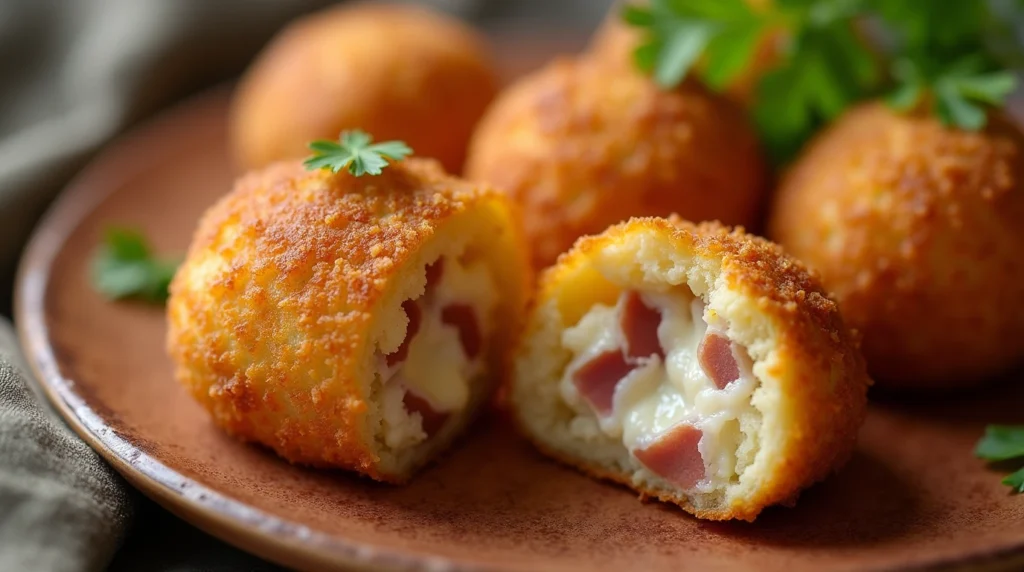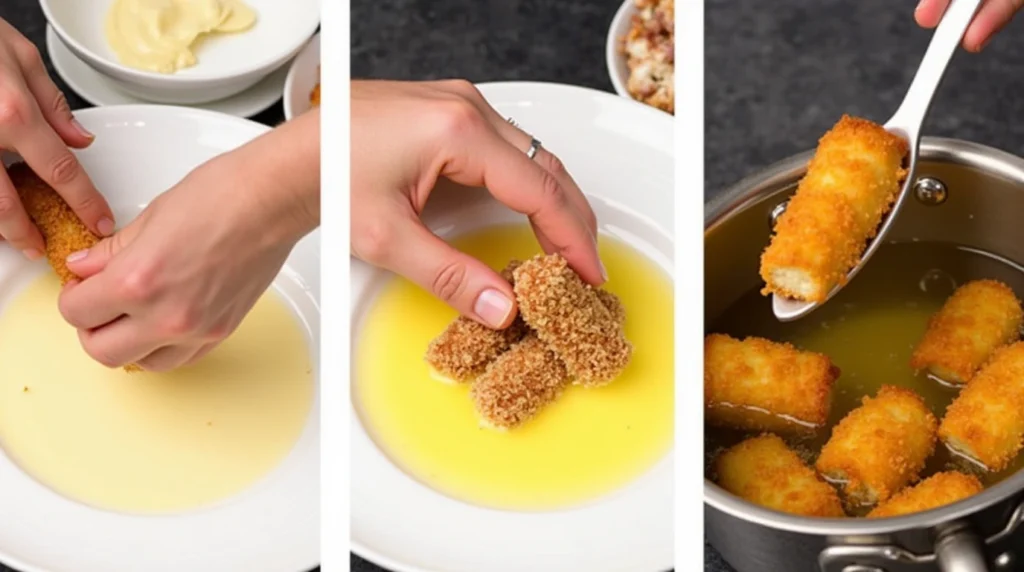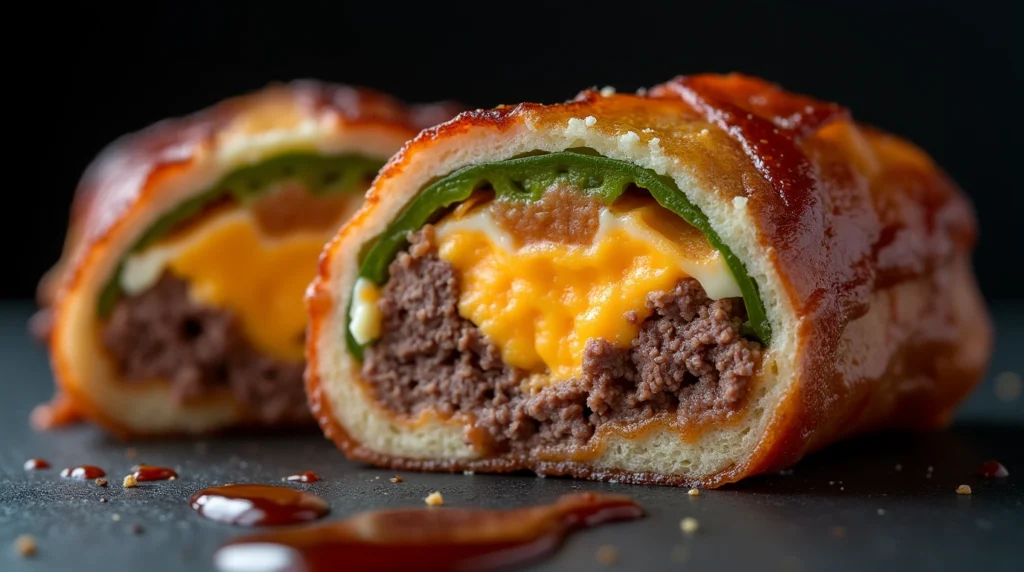jamon iberico

Jamon Iberico Croquettes are the epitome of Spanish tapas culture, representing centuries of culinary tradition distilled into crispy, golden morsels of pure delight.
These exquisite appetizers showcase the prized Jamon Iberico—ham made from black Iberian pigs raised primarily in Spain and Portugal, known for their diet of acorns and unique marbling. The ham’s distinctive nutty flavor permeates a velvety béchamel base, creating a harmony of textures and tastes that has made these croquettes a staple in tapas bars across Spain and now internationally.

The preparation involves crafting a thick, rich béchamel sauce infused with finely diced pieces of the premium ham, allowing it to set before shaping into petite cylinders. Each croquette is then carefully breaded and fried to golden perfection, creating a remarkable contrast between the crisp exterior and the creamy, molten interior that practically melts in the mouth upon the first bite.
What makes Jamon Iberico Croquettes truly special is the careful balance of flavors—the subtle nuttiness of the premium ham, the richness of the béchamel, and the delicate hint of nutmeg all encased in a crispy shell.
They represent the Spanish approach to cooking: transforming high-quality ingredients into something greater than the sum of their parts through technique and tradition. These croquettes are traditionally enjoyed as part of a tapas spread with a glass of fino sherry or crisp Spanish wine, embodying the convivial spirit of Spanish dining culture where food is meant to be shared and savored among friends.
Timing
📌 Number of Servings: 24 croquettes (6-8 servings as an appetizer)
⏳ Preparation Time: 30 minutes + 2 hours chilling time
🔥 Cooking Time: 20 minutes
🥢 Ingredients :
For the béchamel:
✅ 4 tablespoons (60g) unsalted butter
✅ 1/4 cup (60ml) extra virgin olive oil
✅ 1/2 cup (70g) all-purpose flour
✅ 2 cups (480ml) whole milk, warmed
✅ 1/4 teaspoon freshly grated nutmeg
✅ 6 oz (170g) Jamon Iberico, finely diced
✅ Salt and white pepper to taste
For breading and frying:
✅ 3 large eggs, beaten
✅ 2 cups (250g) fine breadcrumbs
✅ 1 quart (950ml) vegetable oil for frying
✅Optional: chopped fresh parsley for garnish
👨🍳 Instructions :

- In a large heavy-bottomed saucepan, heat the butter and olive oil over medium heat until the butter melts.
- Add the flour and stir continuously with a wooden spoon for 2-3 minutes to create a roux, being careful not to let it brown.
- Gradually whisk in the warm milk, stirring constantly to prevent lumps from forming.
- Cook the mixture, stirring frequently, for about 10 minutes until it thickens substantially into a very thick béchamel.
- Add the finely diced Jamon Iberico, nutmeg, salt, and white pepper. Stir well to combine.
- Transfer the mixture to a shallow dish and press plastic wrap directly onto the surface to prevent a skin from forming.
- Chill in the refrigerator for a minimum of 2 hours, or leave overnight, until fully set and cold.
- Once chilled, scoop about 2 tablespoons of the mixture and shape into small cylinders or ovals with your hands.
- Set up a breading station: place the beaten eggs in one bowl and the breadcrumbs in another.
- Dip each croquette first in the beaten eggs, then coat thoroughly with breadcrumbs.
- Preheat the oil in a deep fryer or sturdy pot until it reaches 350°F (175°C).
- Fry the croquettes in batches for 2-3 minutes until golden brown on all sides.
- Lift out using a slotted spoon and place on paper towels to absorb excess oil.
- Serve immediately, garnished with chopped parsley if desired.
💡 TIPS :
- Keep your hands lightly moistened with water when shaping the croquettes to prevent sticking.
- For extra crispiness, double-bread the croquettes by dipping them in egg and breadcrumbs twice.
- If you can’t find Jamon Iberico, substitute with Serrano ham or prosciutto (though the flavor will be different).
- The croquette mixture can be made a day ahead and kept refrigerated.
- You can freeze uncooked breaded croquettes for up to 3 months. First, arrange them on a baking sheet to freeze individually, then move them to a freezer-safe bag once they’re firm.
- Serve with aioli or romesco sauce for dipping.
📊Nutrition Information (per serving)
- Calories: 320
- Total Fat: 22g
- Saturated Fat: 6g
- Cholesterol: 75mg
- Sodium: 450mg
- Total Carbohydrate: 18g
- Dietary Fiber: 1g
- Sugars: 2g
- Protein: 12g
❓ jamon iberico Croquettes FAQ :
- What makes Jamon Iberico different from other hams? Jamon Iberico comes from black Iberian pigs and has exceptional marbling and a distinctive nutty flavor due to the pigs’ diet of acorns.
- Can I make these croquettes ahead of time? Yes! You can prepare the béchamel mixture a day ahead and keep it refrigerated. You can also form and bread the croquettes and refrigerate them for up to 24 hours before frying.
- Why is my croquette mixture too soft to shape? The mixture might need more time to chill or may need a bit more flour in the béchamel. Refrigerate for longer or add a tablespoon of flour to the warm mixture and cook for an additional minute.
- What can I serve with Jamon Iberico Croquettes? They pair wonderfully with aioli, romesco sauce, or a simple squeeze of lemon. A crisp green salad makes a nice accompaniment.
- Can I bake these instead of frying? While traditional croquettes are fried, you can bake them at 400°F (200°C) for about 20 minutes, turning halfway through. Spray them with cooking oil first for better browning.
- How can I tell when the oil is at the right temperature for frying?If you’re without a thermometer, test the oil by adding a small piece of bread—if it sizzles and browns in roughly 60 seconds, the oil is at the right temperature.
- Why did my croquettes burst open during frying? This usually happens if the oil is not hot enough or if there are cracks in the breading. Ensure your oil is at 350°F and that the croquettes are fully sealed with breading.
- How should I store leftover croquettes? Store in an airtight container in the refrigerator for up to 3 days. Reheat in a 350°F (175°C) oven for about 10 minutes to restore crispiness.
- Can I use a different type of milk in the béchamel? Whole milk provides the best richness, but you can use 2% milk. Plant-based milks will significantly alter the flavor and texture.
- What’s the best way to finely dice the ham? Use a very sharp knife and cut the ham into tiny cubes. Alternatively, you can pulse it a few times in a food processor, being careful not to turn it into a paste.
Related

